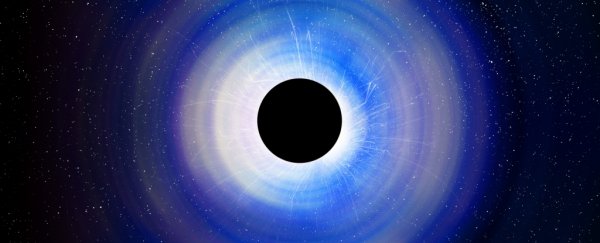Tiny, all-but-undetectable primordial black holes could be one of the mysterious sources of mass that contributes to dark matter. There are significant limits to their lifespan in open space, but in recent years, astrophysicists have asked: what if these black holes are in the core of neutron stars?
Gradually, such black holes would accrete the neutron star, devouring it from within. These hypothetical systems are yet to be verified, but a new preprint paper, published on arXiv and yet to be peer-reviewed, has calculated how long this devouring would take.
This, in turn, could be used to analyse the current neutron star population to constrain the nature of the black holes considered as a dark matter candidate - whether they are primordial, dating back to the Big Bang, or black holes that formed inside neutron stars.
Although we don't know what dark matter is, it's pretty fundamental to our understanding of the Universe: there simply isn't enough matter we can directly detect - normal matter - to account for all the gravity. In fact, there's so much gravity that scientists have calculated roughly 75 to 80 percent of all matter is dark.
There are a number of candidate particles that could be dark matter. Primordial black holes that formed just after the Big Bang are not one of the leading candidates, because if they were above a certain mass we would have noticed them by now; but, below that mass, they would have evaporated via the emission of Hawking radiation long before now.
Black holes, however, are an attractive candidate for dark matter: they, too, are extremely difficult to detect if they're just hanging out in space just doing nothing. So astronomers continue to look for them.
One idea that has been explored recently is the endoparasitic black hole. There are two scenarios for this. One is that primordial black holes were captured by neutron stars, and sink down to the core. The other is that dark matter particles are captured inside a neutron star; if the conditions are favourable, these could then come together and collapse down into a black hole.
These black holes are small, but they wouldn't remain so. From their cosy position, ensconced inside the neutron star, these little black holes would then parasitise their host.
The team of physicists from Bowdoin College and the University of Illinois at Urbana-Champaign calculated the accretion rate - that is, the rate at which the black hole would devour the neutron star - for a range of black hole mass ratios, from three to nine orders of magnitude less massive than the neutron star host.
Neutron stars have a theoretical upper mass limit of 2.3 times the mass of the Sun, so the black hole masses would extend down into the range of dwarf planets.
For a non-rotating neutron star hosting a non-spinning black hole, the accretion would be spherical. At the team's calculated accretion rates, black holes as small as 10-21 times the mass of the Sun would completely accrete a neutron star well within the lifetime of the Universe.
This suggests that primordial black holes, from the beginning of the Universe, would have completely accreted their host neutron stars before now. These timescales are in direct conflict with the ages of old neutron star populations, the researchers said.
"As an important application, our results corroborate arguments that use the current existence of neutron star populations to constrain either the contribution of primordial black holes to the dark matter content of the Universe, or that of dark matter particles that may form black holes at the center of neutron stars after they have been captured," they wrote in their paper.
So the result is another blow for primordial black holes; but it doesn't rule endoparasitic black holes out entirely. If there are globs of dark matter particles out there floating through space and being slurped into neutron stars, they could be collapsing into black holes and converting neutron stars into black hole stuff even as you read this sentence.
And that is freaking awesome.
The team's paper has been published on arXiv.
